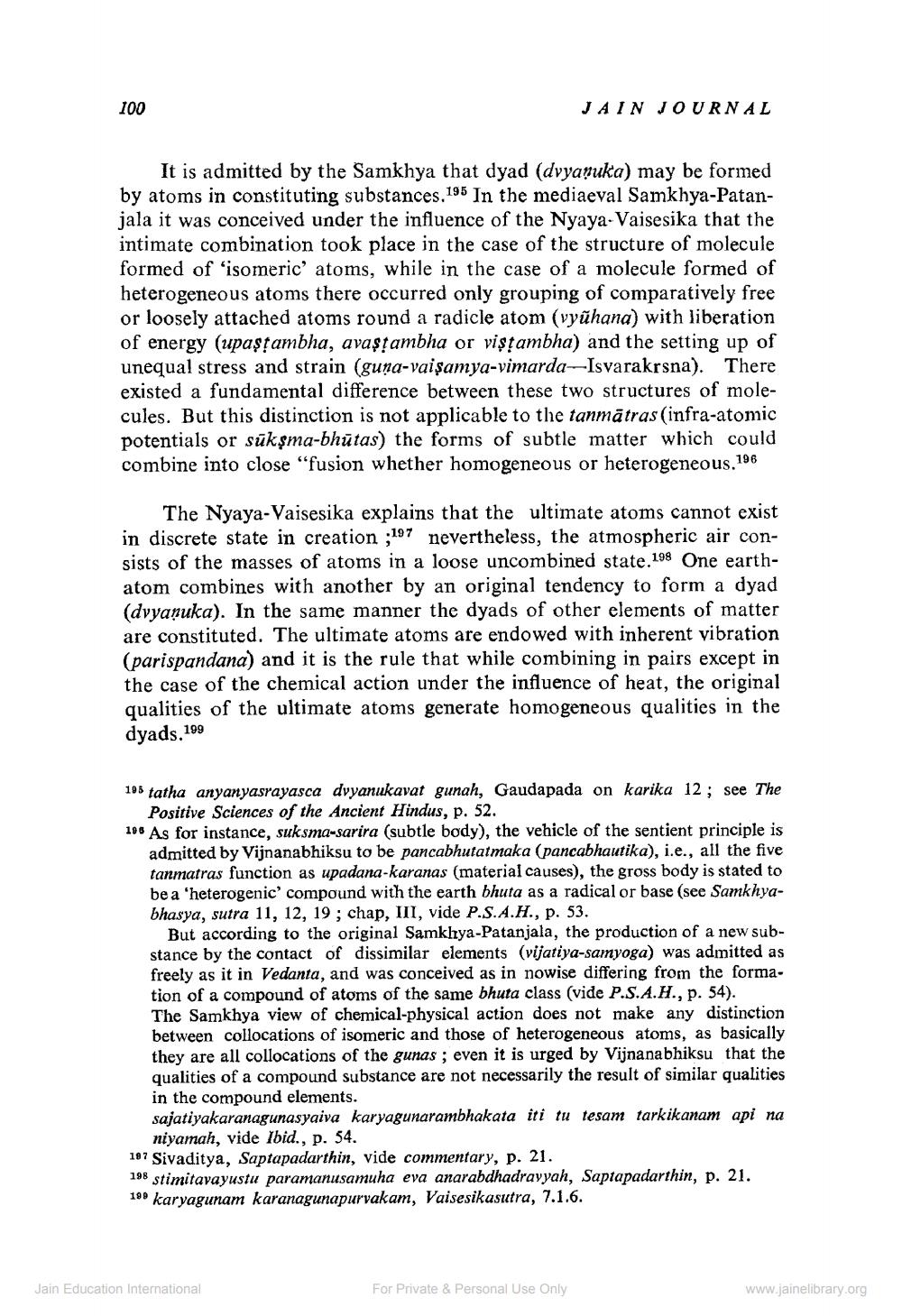________________
100
It is admitted by the Samkhya that dyad (dvyaṇuka) may be formed by atoms in constituting substances.195 In the mediaeval Samkhya-Patanjala it was conceived under the influence of the Nyaya-Vaisesika that the intimate combination took place in the case of the structure of molecule formed of 'isomeric' atoms, while in the case of a molecule formed of heterogeneous atoms there occurred only grouping of comparatively free or loosely attached atoms round a radicle atom (vyuhana) with liberation of energy (upaşṭambha, avaṣṭambha or viṣṭambha) and the setting up of unequal stress and strain (guna-vaiṣamya-vimarda-Isvarakrsna). There existed a fundamental difference between these two structures of molecules. But this distinction is not applicable to the tanmatras (infra-atomic potentials or sūkṣma-bhūtas) the forms of subtle matter which could combine into close "fusion whether homogeneous or heterogeneous.196
JAIN JOURNAL
The Nyaya-Vaisesika explains that the ultimate atoms cannot exist in discrete state in creation ;197 nevertheless, the atmospheric air consists of the masses of atoms in a loose uncombined state.198 One earthatom combines with another by an original tendency to form a dyad (dvyaṇuka). In the same manner the dyads of other elements of matter are constituted. The ultimate atoms are endowed with inherent vibration (parispandana) and it is the rule that while combining in pairs except in the case of the chemical action under the influence of heat, the original qualities of the ultimate atoms generate homogeneous qualities in the dyads, 199
195 tatha anyanyasrayasca dvyanukavat gunah, Gaudapada on karika 12; see The Positive Sciences of the Ancient Hindus, p. 52.
196 As for instance, suksma-sarira (subtle body), the vehicle of the sentient principle is admitted by Vijnanabhiksu to be pancabhutatmaka (pancabhautika), i.e., all the five tanmatras function as upadana-karanas (material causes), the gross body is stated to be a 'heterogenic' compound with the earth bhuta as a radical or base (see Samkhyabhasya, sutra 11, 12, 19; chap, III, vide P.S.A.H., p. 53.
But according to the original Samkhya-Patanjala, the production of a new substance by the contact of dissimilar elements (vijatiya-samyoga) was admitted as freely as it in Vedanta, and was conceived as in nowise differing from the formation of a compound of atoms of the same bhuta class (vide P.S.A.H., p. 54). The Samkhya view of chemical-physical action does not make any distinction between collocations of isomeric and those of heterogeneous atoms, as basically they are all collocations of the gunas; even it is urged by Vijnanabhiksu that the qualities of a compound substance are not necessarily the result of similar qualities in the compound elements. sajatiyakaranagunasyaiva karyagunarambhakata iti tu tesam tarkikanam api na niyamah, vide Ibid., p. 54.
187 Sivaditya, Saptapadarthin, vide commentary, p. 21.
198 stimitavayustu paramanusamuha eva anarabdhadrayyah, Saptapadarthin, p. 21. 199 karyagunam karanagunapurvakam, Vaisesikasutra, 7.1.6.
Jain Education International
For Private & Personal Use Only
www.jainelibrary.org




